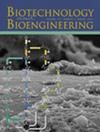基于响应面法和人工神经网络的毕赤酵母重组Tocilizumab生产建模与优化。
IF 3.5
2区 生物学
Q2 BIOTECHNOLOGY & APPLIED MICROBIOLOGY
引用次数: 0
摘要
本研究表明,优化培养基可显著提高毕赤酵母中重组单克隆抗体(mAb) Tocilizumab (TCZ)的全长和Fab片段的生产。在四种被测试的定义培养基中,FM22被发现适合重组菌株的生长和抗体产量。在各种碳源和氮源中,甘露醇和甘氨酸分别适合于提高全长TCZ的产量。同样,山梨醇和硫酸铵分别被发现是合适的碳源和氮源,以提高Fab的产量。采用双水平因子Plackett-Burman设计,发现对TCZ产生显著影响的培养基成分分别为甘露醇、甘氨酸、组氨酸、K2SO4和山梨醇、硫酸铵、KH2PO4和CaSO4.2H2O,分别为全长和Fab。采用响应面法(Box-Behnken Design)对筛选的培养基成分进行优化。人工神经网络(ANN)模型结合遗传算法(GA)进一步改进了预测结果,并显示出对P. pastoris单克隆抗体产生的显著影响。在最佳培养基组分水平下,摇瓶培养中全长TCZ和Fab分别为0.35 mg/L和0.42 g/L。在间歇式反应器(2-L培养)中,在最佳培养基组分水平下,全长TCZ和Fab的产率分别为0.44 mg/L和0.45 g/L。总产量分别是全长TCZ和Fab的3.8倍和2.9倍。本文章由计算机程序翻译,如有差异,请以英文原文为准。
Modeling and Optimization of Recombinant Tocilizumab Production From Pichia pastoris Using Response Surface Methodology and Artificial Neural Network.
This study has demonstrated the optimization of the defined medium that significantly enhanced the production of recombinant monoclonal antibody (mAb) Tocilizumab (TCZ) as full-length and Fab fragment from Pichia pastoris. Out of the four tested defined media, FM22 was found to be suitable for the growth of recombinant strains and antibody yield. Among the various carbon and nitrogen sources tested, mannitol and glycine, respectively, were found to be suitable for the enhanced production of full-length TCZ. Similarly, sorbitol and ammonium sulfate were found to be suitable carbon and nitrogen sources, respectively, for enhanced production of Fab. The medium components that significantly influenced the production of TCZ were found to be mannitol, glycine, histidine, and K2SO4 and sorbitol, ammonium sulfate, KH2PO4, and CaSO4.2H2O for full-length and Fab, respectively, using a two-level factorial Plackett-Burman design. The screened medium components were optimized using response surface methodology (Box-Behnken Design). Artificial neural network (ANN) models combined with genetic algorithms (GA) further improved predictions and showed a remarkable impact on mAb production in P. pastoris. Under the optimal levels of medium components, the full-length TCZ and Fab were determined to be 0.35 mg/L and 0.42 g/L, respectively, in the shake-flask culture. The yield of full-length TCZ and Fab in batch reactor (2-L culture) was found to be 0.44 mg/L and 0.45 g/L, respectively, at the optimal levels of the medium components. The overall increased yields were observed to be 3.8 and 2.9-folds of full-length TCZ and Fab, respectively.
求助全文
通过发布文献求助,成功后即可免费获取论文全文。
去求助
来源期刊

Biotechnology and Bioengineering
工程技术-生物工程与应用微生物
CiteScore
7.90
自引率
5.30%
发文量
280
审稿时长
2.1 months
期刊介绍:
Biotechnology & Bioengineering publishes Perspectives, Articles, Reviews, Mini-Reviews, and Communications to the Editor that embrace all aspects of biotechnology. These include:
-Enzyme systems and their applications, including enzyme reactors, purification, and applied aspects of protein engineering
-Animal-cell biotechnology, including media development
-Applied aspects of cellular physiology, metabolism, and energetics
-Biocatalysis and applied enzymology, including enzyme reactors, protein engineering, and nanobiotechnology
-Biothermodynamics
-Biofuels, including biomass and renewable resource engineering
-Biomaterials, including delivery systems and materials for tissue engineering
-Bioprocess engineering, including kinetics and modeling of biological systems, transport phenomena in bioreactors, bioreactor design, monitoring, and control
-Biosensors and instrumentation
-Computational and systems biology, including bioinformatics and genomic/proteomic studies
-Environmental biotechnology, including biofilms, algal systems, and bioremediation
-Metabolic and cellular engineering
-Plant-cell biotechnology
-Spectroscopic and other analytical techniques for biotechnological applications
-Synthetic biology
-Tissue engineering, stem-cell bioengineering, regenerative medicine, gene therapy and delivery systems
The editors will consider papers for publication based on novelty, their immediate or future impact on biotechnological processes, and their contribution to the advancement of biochemical engineering science. Submission of papers dealing with routine aspects of bioprocessing, description of established equipment, and routine applications of established methodologies (e.g., control strategies, modeling, experimental methods) is discouraged. Theoretical papers will be judged based on the novelty of the approach and their potential impact, or on their novel capability to predict and elucidate experimental observations.
 求助内容:
求助内容: 应助结果提醒方式:
应助结果提醒方式:


